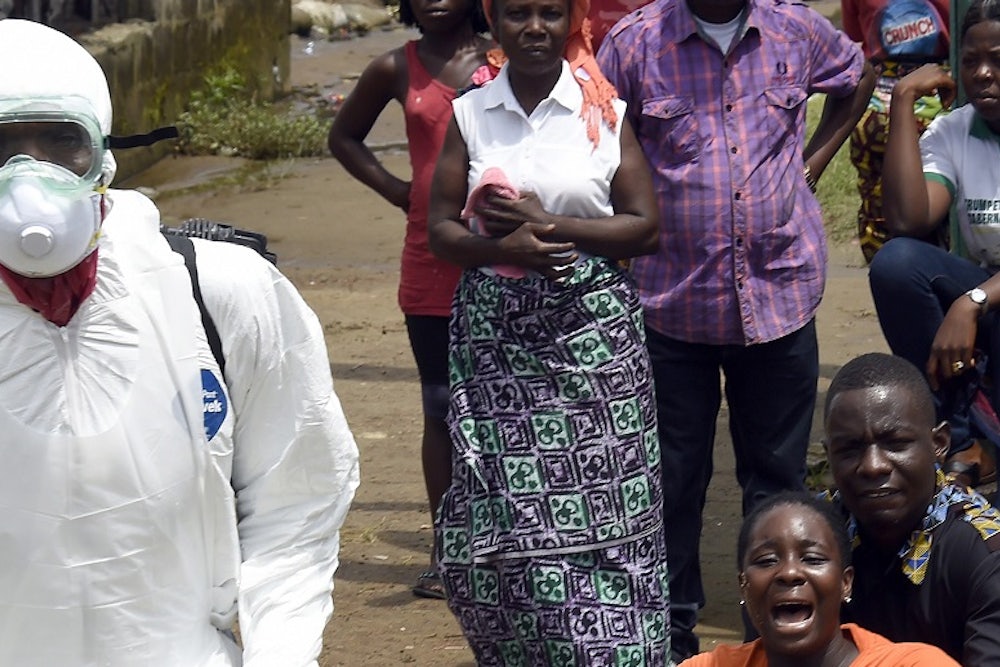When Thomas Eric Duncan boarded a plane in Liberia destined for Dallas, he was not displaying any symptoms of Ebola. Like everyone else travelling from Liberia, his temperature was taken three times at airport screening checkpoints, but he didn’t have a fever. When airport officials asked if he’d been in contact with anyone who had Ebola, he lied and said he hadn’t. Ten days later, he was diagnosed with the virus at Texas Health Presbyterian Hospital, the first case in the United States.
How did this happen? Ebola has an incubation period of up to 21 days, during which an infected person can walk around—and travel—without displaying symptoms. As Abby Haglage explained last week at the Daily Beast, a Colorado-based company named Corgenix is working with scientists at Tulane to develop a mobile, diagnostic test that will allow health officials to test people suspected of having Ebola and receive a result in a matter of minutes. The test isn’t ready yet; it will take at least a few months to develop and test it. If it works, though, it could dramatically help officials control this outbreak.
But there’s a long-term concern, too, that Ebola will become endemic to West Africa—meaning it will be there forever with small outbreaks occurring frequently. In September, the World Health Organization’s Ebola Response Team warned of such an outcome in the New England Journal of Medicine. “[W]e must therefore face the possibility that EVD (Ebola virus disease) will become endemic among the human population of West Africa, a prospect that has never previously been contemplated,” they wrote.
Many other health experts share their concerns. “That’s our biggest fear—that it will be endemic,” said Howard Markel, a medical historian at the University of Michigan. “That’s where you worry there will be little pockets of Ebola, whether in human beings or in bats or other animals, and that we’ll have little outbreaks or big outbreaks for years to come.”
If that does happen, the solution for rapid, in-the-field testing likely won’t be Corgenix’s device. It will be a different diagnostic test developed by a California company called Nanōmix, which has partnered with Corgenix and Tulane researchers. The Nanōmix test is a multiplex device: It can detect multiple diseases at once. This is particularly important in West Africa, where Lassa fever, malaria, and now Ebola are all prevalent. All three of those diseases have similar symptoms—fever, vomiting, diarrhea—but require different treatments. It’s vital for doctors to have a correct diagnosis as early as possible. Nanōmix’s device would do just that in minutes.
The Nanōmix system is simple and safe. The tested blood is self-contained and easy to dispose. “You take whole blood from a patient and you put the whole blood into an inlet port on the cartridge and then you put that cartridge [and] slide it into the reader,” said David Ludvigson, the CEO of Nanōmix. “And then the operator presses the start button. … The cartridge itself contains all of the biology and all of the patient’s sample and the instrument never sees that. It becomes bio disposable.”
The Nanōmix system has already seen some success. It was tested in Africa for Ebola and worked, but more testing is needed to determine the sensitivity of it—what percentage of positives the device actually discovers. “We did do some field testing, but we need to do more,” Dr. Robert Garry, a scientist at Tulane who is working closely with both Corgenix and Nanōmix. “Always more tests.”
Given the severity of the outbreak, it would certainly be better if such a device—or one like Corgenix’s—already existed, but until recently, large companies showed no interest in developing one. Ebola wasn’t prevalent so there was no commercial potential. Small firms like Nanōmix and Corgenix had trouble receiving grants to do the research. “The NIH likes to say, ‘We’ll give you money to work on these but what’s the end game? Will it make a difference in health care?’” said Douglass Simpson, the CEO of Corgenix. “There was no Ebola and so it wasn’t approved.”
As with Corgenix’s device, it’s tough to estimate when Nanōmix’s would be ready to be deployed. Ludvigson said it would take three to four months to produce a fully effective system. Garry agreed, saying that it’s possible it could be ready in that time frame.
But even if it takes longer than that, Nanōmix’s device could prove incredibly valuable for health officials in the long-term, particularly if Ebola becomes endemic in West Africa. "In a few months, [given] the CDC and the WHO projections, we’re looking at something that could even get much, much worse and probably will," Garry said. "These tests could make a difference, so we’re just crossing our fingers."
